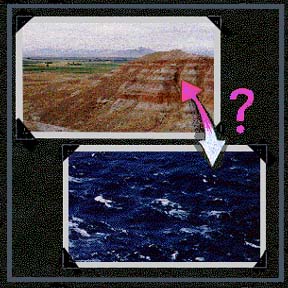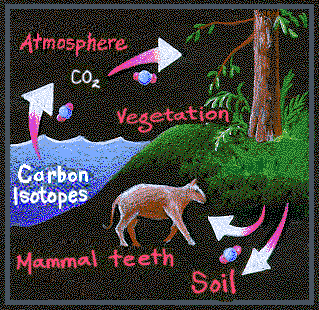
![]()
CROSSING A CLIMATE THRESHHOLD

Connecting the Clues: Land and Sea Linked by Restless Carbon Atoms
The dusty badlands of Wyoming, for example, seem far removed from the deep sea. But paleontologists working in Wyoming thought that the oceanic warming and the appearance of modern mammals happened at about the same time. They based their suspicions on a faint magnetic signal left in land and marine sediments. And since the oceans warmed several degrees, argues Zachos, the climate change must have warmed up life on land.
To learn what happened to the land mammals, you must look for clues in the ocean.
The problem was nailing down the exact timing, Zachos says. There was no obvious physical connection between the mammal bone bed in Wyoming and the deep sea sediments. Koch and Zachos resolve this difficulty by finding a chemical link between mammal teeth and tiny deep sea fossils called foraminifera.
Carbon atoms cycle through the land, sea, and atmosphere.
Land, sea and sky are linked through a rapid mixing of carbon atoms. In one of its many pathways through the world, carbon leaves the ocean as carbon dioxide gas. Plants turn some of this gas into food. Grazing animals incorporate that carbon into their bodies and exhale some carbon dioxide gas back into the atmosphere. The carbon atoms circulate so quickly between the ocean, atmosphere, and land, that at any one time, the same distinct types of carbon atoms, called isotopes, exist in almost every corner of world. These carbon isotopes provide a ubiquitous chemical fingerprint for any time.
But carbon isotopes are fragile clues, even when preserved in rock; heat or migrating fluids can smudge the delicate chemical signal. Tooth enamel, however, locks up carbon isotopes securely. To recover that isotopic fingerprint, Koch and Zachos took a dental drill to the fossilized teeth of Corpyhdon, a tusked, plant-eating mammal the size of a hippo. They placed the powdered enamel in acid, then measured the carbon isotopes. And they found an isotopic fingerprint that closely resembled the marine signal Zachos had extracted from Antarctic foraminifera.
The matching isotopic fingerprints implicate the ocean warming in the mammal appearance, Zachos and Koch concluded. At the end of Paleocene, they point out, North America had not yet split apart from Europe and Asia. If the polar regions had warmed enough, mammals could have migrated into North America. Mary Maas, a Duke University paleontologist who studies the mammal appearance, agrees that the trek is a likely explanation. The ocean warming also affected creatures living in the sea...



